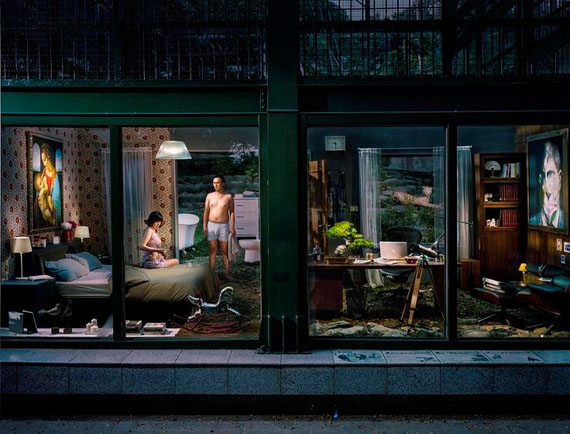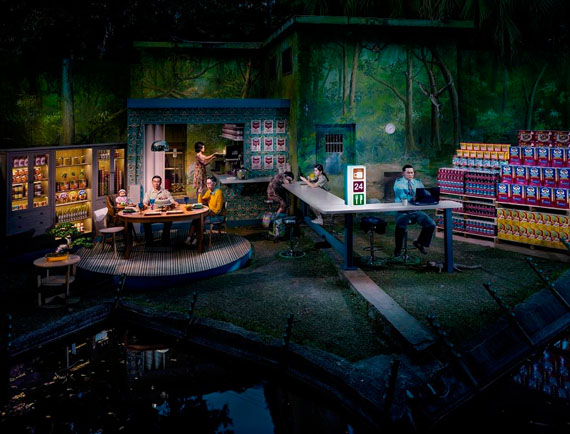
Ching Hui Chou »
Animal Farm
Exhibition: 28 Mar – 17 May 2015
Museum of Contemporary Art (MOCA) Taipei
No. 39, Chang-An West Road
103 Taipei
+886-02-25523721
mei@mocataipei.org
www.mocataipei.org.tw
Tue-Sun 10-18

Ching-hui Chou ’s work since the 1990s often features in-depth depiction of specific groups of people or communities in modern society. In all projects, Chou always ensures that his subjects have enough trust in him and that constant interaction is maintained. He also conducts research and investigation in advance for him to acquire sufficient understanding of topics before he presses the shutter. While inspired by social issues and events, Chou applies an artistic approach that seeks to interpret true stories through near-theatrical representations. He believes that the storytelling aspect of fine art photography is a more effective way of presenting and annotating familiar stories in our surroundings. In Frozen in Time: Images of a Leper Colony, for instance, “unlike those who organize and construct ideas only after photos are taken, I had the concept of the project all drafted out before heading out to take photos,” said Chou. “The real terrified thing is not leprosy itself, but the imaginations that people have about disease. I wanted to recreate common imaginations by regular people about leprosy through photography. I highlighted three angles. One was death as experienced by those afflicted by the disease. Their path to and after death was entirely confined in the sanatorium, including cremation and placement of cinerary urns. The other angle was religion. Spiritual support became tremendously important for those who were quarantined. The third was their daily life and medical treatment they received,” he explained.
Animal Farm, Ching-hui Chou ’s solo exhibition at MOCA Taipei, is based on his five-year-long photography project that involved a large team and significant funding. In this project, Chou turns to zoos as his muses and sites of actual photo making, where vivid tableaus are created to suggest the sumptuous yet often baffled life of modern civilization. The project entails a series of tedious and complex tasks such as writing project proposals, applying permission for site use, fundraising, casting actors, preparing equipment, and producing photography properties. In the past two years, he and his production crew stayed at Hsinchu Zoo and Shoushan Zoo several times, each over an extended period of time to execute the project. Theatrical sets were fabricated against the zoo environment where the actors played their assigned roles as photos were taken at dawn and dusk. By so doing, Chuo inserted surreal theatrical scenes and lifelike vernacular spaces into artificial enclosures in which wild animals were brought together and domesticated. Absurdity and displacement were emphasized as the artist situated humans among animals that were reminiscent of specimens. The home now looked like a cage, while the border between manmade interiors and the wilderness became blurred. A series of eerie yet visually opulent images were formed, much like still photos of stage plays jointly presented by the human beings and the animals in them.
This exhibition is organized under three themes. The first theme, Bodily Existence, the second theme, Life Boundary, and Social Environmental Frame represents the third theme. On display include portraits of actors in their stage look, nine epic large-scale photographs staged and shot at zoos, and nine videos of performances recorded at the studio and a recycling center. Also featured in the exhibition are an elephant barn that allows the audience to enter and experience the photo shooting backdrop and a multimedia installation through which the behaviors and living environment of brown bears can be observed. For Ching-hui Chou, photography represents a tool for social observation and reflection and demonstrates the power of images. It also provides means for validating one’s self and existence. That is, in Chou’s words, “Speaking my mind through images, which in turn accounts for the value of my existence. Through photography, I can experience more possibilities of life.”
Exhibition Statement
Ching-hui Chou’ s photographs were all shot with 8 x 10 format color films. Through these exquisite images with saturated colors, he was able to present a visual quality that surpassed ordinary vision. Combined with a surrealistic scene and atmosphere, he guided the audience to gradually inspect all the elements and details in the images, searching for clues for interpreting these mysterious pictures to connect or resonate with their personal experiences. Chou negotiated to use Hsinchu Zoo and Shoshan Zoo in Kaohsiung as the sets of his photography project, and deliberately chose the twilight moment to shoot his works. In his opinion, the moment when light and colors blurred as well as when day transitioned into night was the perfect temporal equivalent for delineating the overlapping condition of the overt and covert tendencies in human psyche.
While creating this so-called “directed photography” that is grand and theatrical in style and serves as a form of social discourse, Chou has also made close-up, sympathetic portraits for individual character on his sets. These secular characters were styled in fashionable clothing and looks from the 70s, revealing the artist’s particular, nostalgic feelings for a certain belle époque in the past. The representation of their clear visages and postures as ordinary people, on the other hand, contrasted the inescapable yet gradually numbing human condition in the contemporary social and cultural environment they lived in.�